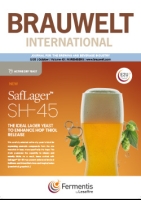Samples of barley grains from 10 varieties and 8 locations were analysed on 48 mineral nutrients and 13 malt quality parameters. The article presents means, ranges of variation and (expanded) measurement uncertainties. For many elements a significant influence of varieties could be found. The statistical analysis includes the calculation of coefficients of correlation between the element content and the quality parameters using a covariance analysis in order to eliminate the variety effects (partial coefficent rp). The closest positve rp (adjusted by varieties) to malt quality have been found for K, Pb, Mo and Na. Most of minerals correlate negatively to the malt quality index, especially Zn (rp = –0,67), Mg (rp = –0,47) and Fe (rp = –0,43)..
Due to a shortage of hops in crop 2008, many breweries used Isomerized Kettle Extract instead of regular CO2 extracts to save alpha acids. This worked very well and most of the brewers who used IKE for crop 2008 plan to continue doing so for crop 2009, even though hops are again available in larger quantities.
The 2007 debut could certainly be regarded as successful. The second drink technology India, organised by Messe München (Munich Exhibitions), which took place on November 27th and 28th, 2008 in the Grand Hyatt Hotel in Mumbai, India, was meant to build on this success. Many foreign exhibitors had come to Mumbai in order to present their technology to visitors or to exchange information in the conferences and exhibitor forums held in parallel. These peaceful intentions were shattered by the terrible acts of terror in Mumbai on the eve of the exhibition. Fortunately, all participants came away uninjured, some exhibitors had accommodation in the hotels affected.
ns-LTP1 belongs to the non-specific protein class of lipid transfer proteins (ns-LPTs) that are ubiquitous in plants. ns-LPT1 that occurs, in particular, in the aleurone layer of cereal grains in high concentrations, most probably with a role to play in pathogen defence, shows characteristics (molecular weight, isoelectric point, amphoteric character) that predestine the protein to be a main trigger for the emergence of primary gushing, in line with the literature published on gushing. The hypothesis postulated in 2002 by Hippeli and Elstner [1] has been verified in the context of AiF Projects 13468 N and 14551 N.
Heterogeneous spring barley in the EU
Careful equipment selection and optimised process engineering allow higher capacities to be reached in brewing liquor production. Installation of modern equipment minimises waste water quantities and reduces operating costs.
Hops, the “Medicinal Plant of the Year 2007”, is the only ingredient, other than water, yeast and malt, permitted in brewing of beer in compliance with the German ‘Reinheitsgebot’ (Purity Law). The annual prize was awarded by ‘Studienkreis Entwicklungsgeschichte der Arzneipflanzenheilkunde’ (Study Group History of the Development of Medicinal Plant Botany) at Würzburg University.
As heterogeneous the sowing of the spring barley has started in Europe, as heterogeneous seems the harvest is going to be. The first preliminary results show values that vary a lot. Anyhow there is the talk of overage of brewing barley in Europe. Normally diseases and fusarium are not a big problem.
A good brewery draws on its prior experience to brew a beer using few ingredients, which is tasty and popular with customers. The Paderborner Brewery adopted a similar strategy when it optimized its compressed air production system in cooperation with Ingersoll Rand Air Solutions, a company based in Mühlheim, Germany. The optimization procedure was achieved with few modifications and was implemented without incurring high investment costs. The results surpassed expectations. Annual energy costs were reduced by approximately 55 000 EUR with an amortization period of just over one year.
In Europe, heterogeneous spring barley is growing up. Depending on the time of sowing and the falls of rain during the process of growing, different yields are expected. But to all intents and purposes the branch is expecting an average yield in quality and quantity. Diseases are kept in reasonable limits because of the lasting dryness.
The use of reduced iso-alpha-acids in brewing has become more widespread in past years, although their characteristics during beer ageing are not completely known. During our investigations, important differences in ageing characteristics were detected not only between the categories of reduced and non-reduced hop extracts, but also within the group of beers containing reduced hop products. Forced ageing in the absence of light had the strongest impact on beers hopped with CO2-extract, followed by iso-alpha-extracts. Rho, Tetra and Hexa showed a significantly better stability with the tendency to improve from Rho- over Tetra- to Hexahydro-isohumulone. The findings from sensory analysis could be confirmed by instrumental analysis of chemiluminescence behaviour..


